Your fitness watch’s readiness score combines sleep quality, heart rate variability, and recent training load to predict your body’s exercise capacity. Focus on weekly trends rather than daily fluctuations, as single scores can mislead you. High scores (80-100%) indicate you’re ready for intense workouts, while low scores (below 70%) suggest prioritizing recovery or light activity. Don’t ignore how you actually feel—combine objective data with your body’s signals for the most effective training decisions and injury prevention strategies ahead.
Understanding the Science Behind Readiness Score Calculations
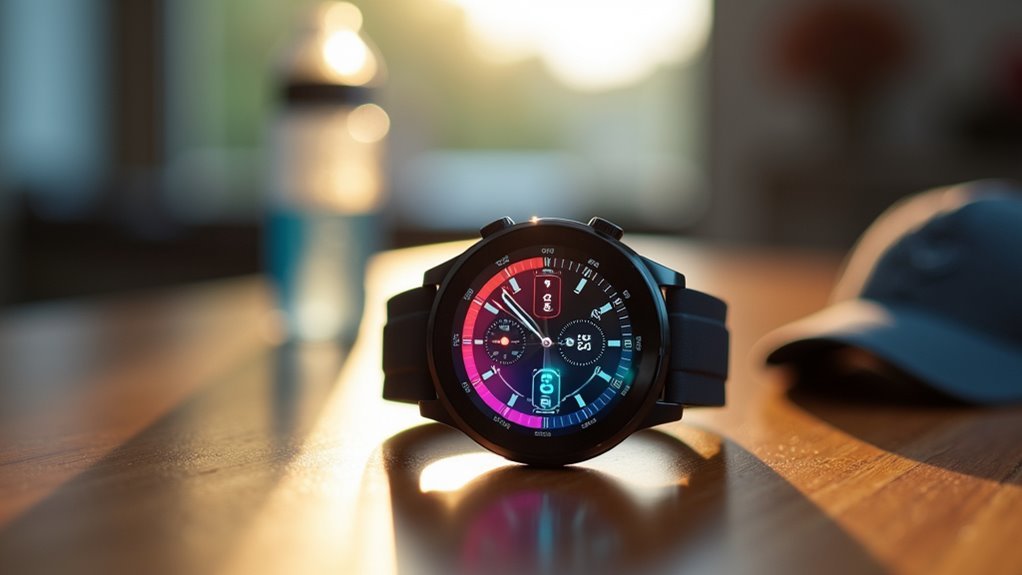
When you glance at your fitness tracker’s readiness score each morning, you’re seeing the result of complex algorithms that analyze multiple physiological data points to determine whether your body is prepared for intense activity or needs recovery time.
Your device processes inputs like sleep duration, heart rate variability, resting heart rate, and recent activity levels. Each manufacturer weighs these factors differently—Fitbit prioritizes sleep periods over three hours, while Garmin and Oura use their own proprietary formulas.
The algorithms make behavioral assumptions that less sleep or intense exercise typically lowers your readiness. However, these calculations can oversimplify your actual physiological state, missing contextual factors like stress, nutrition, or emotional well-being that greatly impact your true recovery status. Studies reveal that manufacturers don’t disclose their exact algorithmic formulas, making it difficult to understand how your specific metrics translate into your daily score.
Key Physiological Metrics That Impact Your Daily Scores
Behind these complex algorithms lie five core physiological metrics that form the foundation of your daily readiness score. Your watch continuously monitors these essential signs to determine how prepared your body is for physical activity.
| Metric | What It Measures | Impact on Readiness |
|---|---|---|
| Heart Rate Variability (HRV) | Variation between heartbeats | Higher HRV = Better recovery |
| Resting Heart Rate (RHR) | Heart rate during rest | Lower RHR = Improved fitness |
| Sleep Quality & Duration | Recovery through sleep | Better sleep = Higher readiness |
| Blood Oxygen Levels | Tissue oxygenation efficiency | Higher levels = Enhanced performance |
| Muscle Readiness | Muscle function status | Better function = Increased scores |
These metrics work together, creating a thorough picture of your body’s current state and recovery capacity. The distinction between aerobic and muscle components allows for more precise training decisions, helping you understand whether your cardiovascular or muscular systems need more attention.
How Different Watch Brands Calculate and Display Readiness
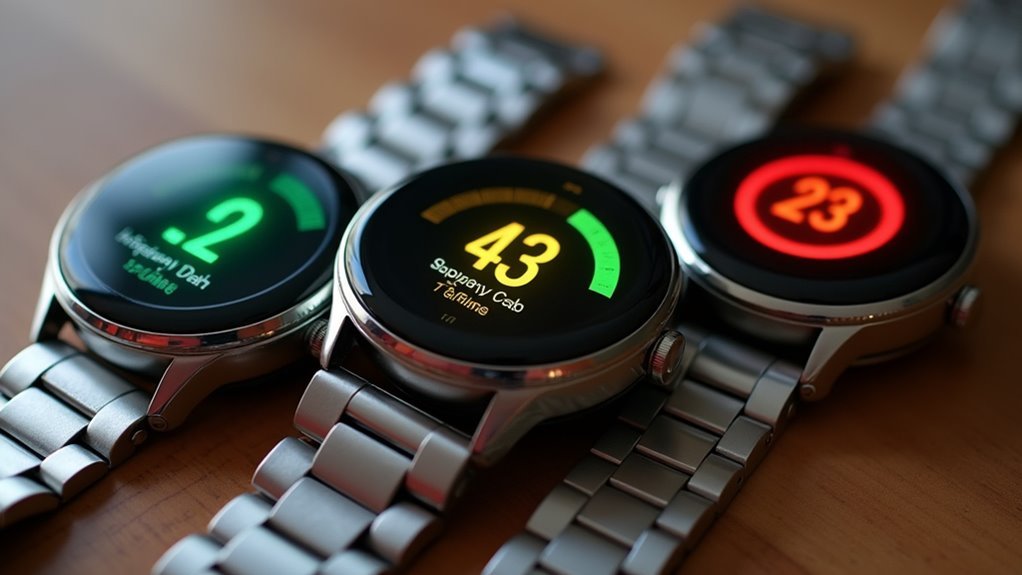
Your readiness score isn’t calculated the same way across different watch brands, even when they’re measuring identical physiological data.
Each manufacturer uses proprietary algorithms that weigh factors like heart rate variability, sleep quality, and recent activity differently, which means you’ll see varying scores between an Oura Ring, Fitbit, and Apple Watch.
The way these scores appear in your companion app also differs considerably, ranging from simple numerical displays to detailed breakdowns with personalized recommendations. Most systems use a 0-100 scale to indicate your body’s preparedness for daily activities and challenges.
Brand-Specific Algorithm Differences
While all major fitness watches measure heart rate variability and resting heart rate as foundational metrics, each brand’s proprietary algorithm creates distinctly different readiness scores from the same physiological data.
Garmin’s Body Battery algorithm emphasizes training load balance, using Firstbeat analytics to weigh acute versus chronic stress with impressive accuracy below 10% MAPE. However, users often report that Garmin’s recovery recommendations can be overly cautious, leading to discrepancies between actual workout readiness and suggested recovery time.
Apple Watch integrates VO2 max trends and active calories but shows less reliability with over 10% MAPE variance.
Samsung’s AI-driven Energy score combines body composition data from their BioActive sensor for holistic daily guidance.
Whoop focuses exclusively on strain-recovery balance through HRV analysis, while Fitbit uses machine learning to refine predictions over time, achieving moderate 10% MAPE accuracy for personalized recommendations.
Score Display Variations
Beyond these algorithmic differences, the way brands present readiness scores to users varies dramatically in both visual design and accessibility.
You’ll find displays combining numbers with green/yellow/red color coding and progress charts for quick visual interpretation. Some brands place scores prominently on main screen widgets, while others tuck them in health tabs requiring navigation.
Calculation transparency differs greatly—some brands provide detailed subscore breakdowns for sleep, activity, and heart metrics through tooltips, while others only show composite results.
You’ll need to tap info buttons for explanations, as exact formula weighting remains unclear across platforms. Certain devices require app access exclusively for viewing readiness metrics rather than displaying them directly on the wearable interface.
Most brands integrate readiness with recovery advice, cardio load recommendations, and guided sessions, invigorating scores daily after sleep cycles for peak accuracy.
Interpreting Score Ranges for Optimal Training Decisions
Your readiness score acts as a traffic light for your training decisions.
When you see high scores, you’re getting the green light to push hard with intense workouts since your body’s fully recovered.
Low scores signal it’s time to shift into recovery mode, while moderate scores suggest you’ll thrive with a balanced approach that doesn’t overtax your system. However, some users experience high readiness scores despite feeling fatigued, so it’s important to also listen to your body’s signals alongside the data.
High Score Training Go
Workout readiness scores between 90 and 100 represent your body’s green light for high-intensity training sessions. You’re at peak performance potential, meaning your cardiovascular system, recovery state, and stress levels are ideally aligned for challenging workouts.
When you see these high scores, you can confidently push your training intensity and consider incorporating new exercises or increasing your current load. Your HRV, resting heart rate, and sleep quality are working together to signal you’re well-adapted and ready for more demanding sessions.
However, don’t ignore other factors like your cardio load history. Even with high readiness scores, you’ll want to balance intensity with adequate recovery time. These optimal scores also provide crucial injury prevention benefits while maximizing your performance improvements.
These scores indicate you’re managing training stress effectively, but consistent monitoring prevents overtraining while maintaining your performance edge.
Low Score Recovery Mode
When your watch displays workout readiness scores below 70, it’s signaling that your body needs prioritized recovery over intense training. These low scores reflect inadequate time for your muscles, heart, and nervous system to repair after exertion.
Your device calculates this through heart rate recovery, sleep quality, stress markers, and training load. If your heart rate doesn’t drop at least 13 BPM within one minute post-exercise, you’re likely seeing reduced scores.
| Recovery Factor | Poor | Good |
|---|---|---|
| Sleep Quality | <6 hours | 7-9 hours |
| HRR (1 min) | <13 BPM | >22 BPM |
| Training Load | High daily | Balanced |
| Stress Level | Elevated | Managed |
Address low scores by reducing training intensity, prioritizing sleep, managing stress, and ensuring proper hydration. Remember that these devices provide fitness estimates rather than precise laboratory-level measurements, so focus on overall trends rather than daily fluctuations. Consistently ignoring these signals increases injury risk and prolongs recovery time.
Moderate Score Balanced Approach
Moderate workout readiness scores between 30-64 indicate you’re in the sweet spot for balanced training decisions.
Your body’s showing typical recovery levels, influenced by sleep quality, recent activity intensity, and heart rate variability. You can maintain medium-intensity workouts without excessive strain while staying alert to fluctuating scores that may require intensity adjustments.
These scores reflect both short-term metrics like overnight sleep and long-term averages spanning 14 days. Understanding individual metrics helps you make more informed decisions than relying solely on a single readiness number.
Focus on maintaining activity balance through tailored workouts that match your current readiness level. Incorporate active recovery techniques and sustain a balanced lifestyle with adequate sleep and nutrition.
Common Misconceptions About What Readiness Scores Actually Mean
Despite their widespread popularity, readiness scores from fitness trackers often mislead users about their true meaning and limitations. You might assume these scores directly predict your race performance, but they only indicate general readiness for activity. Different brands like Fitbit, Garmin, and Oura use unique algorithms, creating inconsistent scores for identical conditions.
| Misconception | Reality |
|---|---|
| Scores guarantee performance | Only indicate general readiness |
| All devices score similarly | Each brand uses different algorithms |
| Low scores mean don’t exercise | Personal feelings matter more |
You shouldn’t let scores dictate your training decisions entirely. These composite numbers simplify complex physiology, potentially masking specific issues like poor sleep or stress. Over-reliance can create unnecessary anxiety and discourage beneficial workouts when you’re actually feeling capable. Rather than relying solely on algorithmic calculations, you should listen to your body and consider how you genuinely feel throughout the day.
Establishing Reliable Baselines for Accurate Score Interpretation

You’ll need to wear your smartwatch consistently every single day to build a trustworthy baseline for your readiness scores.
Your device requires at least seven consecutive nights of sleep tracking plus daily activity monitoring to establish this personal benchmark.
Without this consistent data collection, your readiness scores won’t accurately reflect your true recovery status or training capacity. Once established, calculate your personal baseline by taking the sum of your daily totals divided by seven to create your weekly average.
Consistent Daily Wear Habits
When establishing reliable workout readiness scores, your watch needs consistent daily wear patterns to build accurate physiological baselines. You’ll want to wear your device continuously, including overnight, since algorithms require uninterrupted data streams from sleep cycles, heart rate variability, and daily activities. Removing your watch frequently creates gaps that skew metrics and delay baseline establishment.
| Wear Practice | Impact on Readiness Scores |
|---|---|
| 24/7 Consistent Wear | Enables thorough data capture and reliable baseline calculation |
| Frequent Removal | Creates data gaps, delays baseline establishment, reduces accuracy |
| Sporadic Wear Patterns | Disrupts trend analysis and prevents readiness features from activating |
Maintain the same wrist positioning and guarantee snug-but-comfortable fit. Your watch performs continuous calculation of readiness metrics throughout the day, constantly updating your training status based on incoming physiological data. Sync regularly with your companion app, as consistent data transfer updates baselines in real-time and improves score accuracy.
Seven Day Minimum Period
Your watch requires a minimum seven-day period to establish reliable baselines that accurately interpret workout readiness scores. This timeframe captures natural variance in daily activity and physiological metrics while accounting for differences between weekdays and weekends.
Without seven days of data, your baseline risks being skewed by atypical behaviors or one-off anomalies. A full week smooths out irregular fluctuations from stress, sleep disruptions, or sporadic workouts. It enhances reliability of physiological signals like heart rate variability and resting heart rate.
Once established, you’ll compare daily readiness scores against this stable baseline to identify meaningful deviations indicating changes in recovery or stress. Modern fitness trackers can monitor multiple health metrics including sleep quality, body temperature, and hydration levels to provide comprehensive readiness assessments. This approach prevents misinterpretation and enables personalized fitness insights tailored to your unique patterns.
Using Trends Over Time Instead of Single Daily Readings
While a single day’s readiness score can feel discouraging or overly optimistic, analyzing trends over weeks and months provides a far more accurate picture of your fitness journey.
Daily fluctuations don’t tell the complete story – your body’s recovery patterns emerge through longer observation periods.
Trend analysis reduces the impact of daily variability by averaging out temporary spikes and dips in your metrics. This approach helps you identify genuine patterns of improvement or decline, rather than reacting to isolated readings that might mislead your training decisions.
Your watch’s trend data becomes predictive, showing when you’re genuinely building fitness versus approaching overtraining. The new 28-day training load feature establishes a baseline that allows you to compare weekly patterns against your longer-term average for more accurate strain assessment.
You’ll spot seasonal changes in your recovery patterns and make smarter decisions about workout intensity.
Focus on the trajectory, not the destination.
Combining Readiness Scores With Subjective Body Awareness
Beyond the objective data your watch provides, your body sends its own signals that deserve equal attention in determining workout readiness. Your wearable can enhance your interoceptive awareness, helping you become more attuned to both emotional and physical states before exercising.
Your body’s internal signals matter just as much as your watch’s data when deciding whether you’re ready to exercise.
When you combine subjective self-assessment with objective readiness scores, you’ll create a more thorough understanding of your body’s condition.
This technological embodiment creates a continuous feedback loop between you and your device, enhancing your body perception and decision-making. Features like guided breathing can help you manage stress and improve readiness by reducing emotional barriers to exercise. Your device’s heart rate variability sensors provide crucial stress indicators, with lower HRV typically signaling higher stress levels that may affect your workout performance.
Your watch becomes an extension of your body, providing digital proprioception that influences how you perceive your physical state and make workout decisions.
Adjusting Training Intensity Based on Your Current Score
When readiness scores align with your body’s signals, the next step involves translating these insights into actionable training decisions. Your watch provides data-driven guidance that helps optimize performance while preventing overexertion.
| Readiness Score | Training Intensity | Recommended Focus |
|---|---|---|
| High (80-100%) | Intense workouts | Volume/technique challenges |
| Moderate (60-79%) | Steady-state training | Maintain current intensity |
| Low (40-59%) | Light activity | Active recovery sessions |
| Very Low (<40%) | Rest or mobility | Prioritize sleep/nutrition |
High scores indicate you’re primed for challenging sessions with minimal physiological cost. You’ll recover faster and perform better. Low scores suggest your body needs recovery time—pushing through anyway increases fatigue and prolongs recovery periods. Advanced systems can differentiate between aerobic and muscle readiness to provide more specific training recommendations. Adjust your training load accordingly to maximize long-term progress and reduce injury risk.
Preventing Overtraining and Injury Through Smart Score Application
Understanding your watch’s readiness scores creates a powerful defense against overtraining and injury when you apply them strategically. Your device tracks multiple physiological markers that reveal when your body needs rest before problems develop.
- Monitor HRV trends consistently – Sustained readings below your normal range indicate accumulated fatigue and increased injury risk, signaling it’s time to scale back intensity.
- Heed persistent low readiness warnings – When scores stay depressed for days, your autonomic nervous system is struggling to recover from training stress.
- Watch for mismatched signals – If you feel restless but fatigued, trust your objective scores over subjective feelings to avoid pushing through physiological stress.
- Adjust protocols immediately – Low scores demand active recovery, sleep optimization, or complete rest days to prevent overtraining syndrome. Coaches who monitor their athletes’ readiness data gain valuable visibility into when intervention is needed to prevent performance decline.
Frequently Asked Questions
Can I Still Exercise When My Readiness Score Shows Zero?
You shouldn’t exercise intensely with a zero readiness score as it indicates extreme fatigue. Instead, prioritize rest or try gentle, low-intensity activities like walking to support recovery.
How Long Does It Take for My Readiness Score to Recover?
Your readiness score typically recovers within 0 to 96 hours, depending on workout intensity, sleep quality, and stress levels. Light activities can accelerate recovery while poor sleep extends it.
Should I Take Supplements if My Readiness Score Is Consistently Low?
You shouldn’t rely solely on supplements for consistently low readiness scores. Address underlying issues like sleep quality, stress management, and recovery habits first. Supplements can help but aren’t substitutes for proper lifestyle changes.
Do Readiness Scores Work Accurately for People Over 60 Years Old?
Readiness scores aren’t as accurate for you if you’re over 60. Most devices use algorithms calibrated for younger adults, so age-related changes in heart rate and recovery patterns can skew your results.
Can Stress From Work or Relationships Affect My Workout Readiness Score?
Yes, stress from work or relationships directly impacts your workout readiness score by decreasing heart-rate variability and increasing overall stress load, which reduces recovery capacity and lowers your readiness.
In Summary
You’ll maximize your training potential by treating readiness scores as guidance rather than gospel. Don’t let a single low score derail your workout plans—instead, track trends over weeks and combine data with how you’re actually feeling. Remember that these metrics aren’t perfect predictors, but they’re valuable tools when you understand their limitations. Stay consistent with monitoring, trust your body’s signals, and you’ll develop intuitive training wisdom.

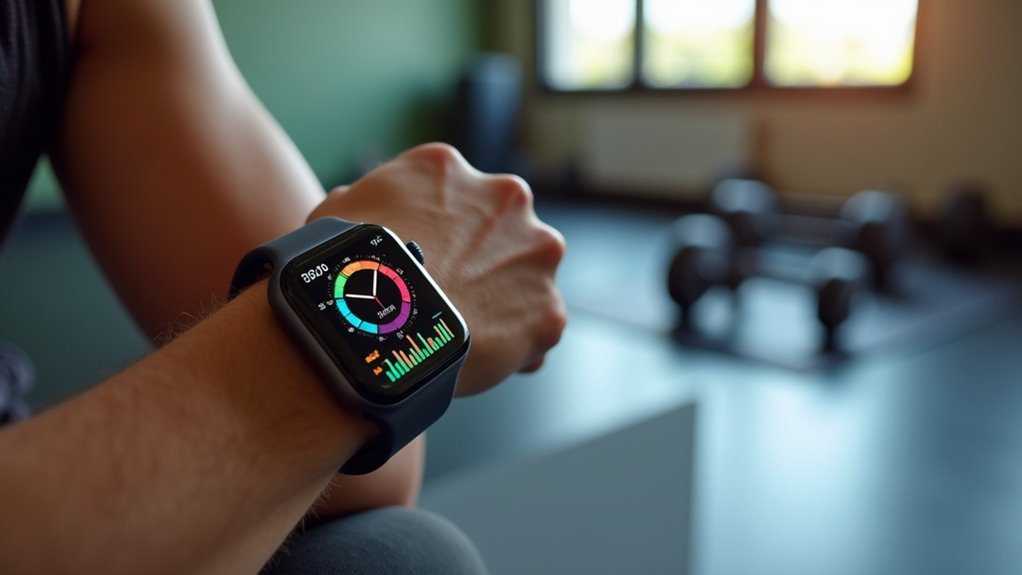
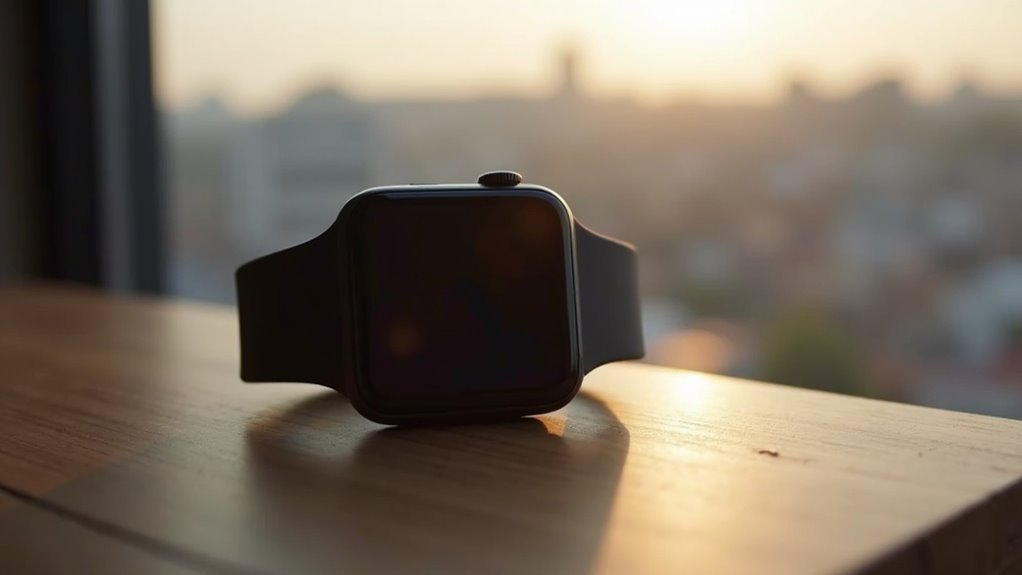
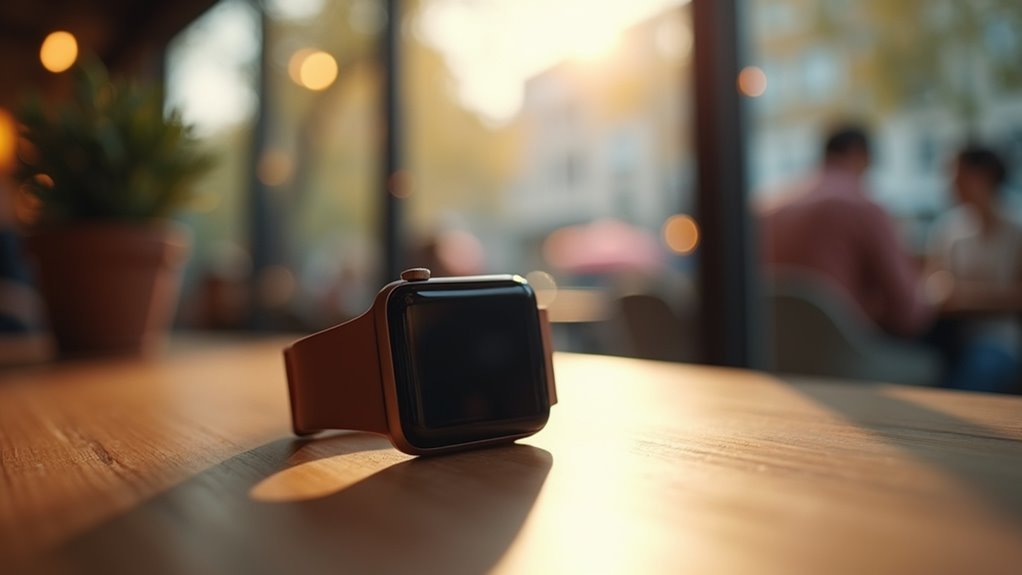

Leave a Reply